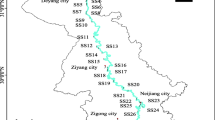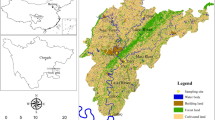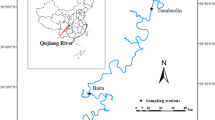Abstract
Water quality degradation in river systems has caused great concerns all over the world. Identifying the spatial distribution and sources of water pollutants is the very first step for efficient water quality management. A set of water samples collected bimonthly at 12 monitoring sites in 2009 and 2010 were analyzed to determine the spatial distribution of critical parameters and to apportion the sources of pollutants in Wen-Rui-Tang (WRT) river watershed, near the East China Sea. The 12 monitoring sites were divided into three administrative zones of urban, suburban, and rural zones considering differences in land use and population density. Multivariate statistical methods [one-way analysis of variance, principal component analysis (PCA), and absolute principal component score—multiple linear regression (APCS-MLR) methods] were used to investigate the spatial distribution of water quality and to apportion the pollution sources. Results showed that most water quality parameters had no significant difference between the urban and suburban zones, whereas these two zones showed worse water quality than the rural zone. Based on PCA and APCS-MLR analysis, urban domestic sewage and commercial/service pollution, suburban domestic sewage along with fluorine point source pollution, and agricultural nonpoint source pollution with rural domestic sewage pollution were identified to the main pollution sources in urban, suburban, and rural zones, respectively. Understanding the water pollution characteristics of different administrative zones could put insights into effective water management policy-making especially in the area across various administrative zones.


Similar content being viewed by others
References
Aksentijević S, Kiurski J, Vasić MV (2012) Arsenic distribution in water/sediment system of Sevojno. Environ Monit Assess 184(1):335–341
Barringer JL, Bonin JL, Deluca MJ, Romagna T, Cenno K, Alebus M, Kratzer T, Hirst B (2007) Sources and temporal dynamics of arsenic in a New Jersey watershed, USA. Sci Total Environ 379(1):56–74
Brown TC, Froemke P (2012) Nationwide assessment of nonpoint source threats to water quality. BioScience 62(2):136–146
Chai C, Yu Z, Song X, Cao X (2006) The status and characteristics of eutrophication in the Yangtze River (Changjiang) Estuary and the adjacent East China Sea, China. Hydrobiologia 563(1):313–328
Daoji L, Daler D (2004) Ocean pollution from land-based sources: East China Sea, China. Ambio 33(1):107–113
Davis AP, Shokouhian M, Ni S (2001) Loading estimates of lead, copper, cadmium, and zinc in urban runoff from specific sources. Chemosphere 44(5):997–1009
Gozzard E, Mayes W, Potter H, Jarvis A (2011) Seasonal and spatial variation of diffuse (non-point) source zinc pollution in a historically metal mined river catchment, UK. Environ Pollut 159(10):3113–3122
Guo H, Wang T, Louie P (2004) Source apportionment of ambient non-methane hydrocarbons in Hong Kong: application of a principal component analysis/absolute principal component scores (PCA/APCS) receptor model. Environ Pollut 129(3):489–498
Howarth RW, Sharpley A, Walker D (2002) Sources of nutrient pollution to coastal waters in the United States: implications for achieving coastal water quality goals. Estuar Coast 25(4):656–676
Huang F, Wang X, Lou L, Zhou Z, Wu J (2010) Spatial variation and source apportionment of water pollution in Qiantang River (China) using statistical techniques. Water Res 44(5):1562–1572
Kavcar P, Sofuoglu A, Sofuoglu SC (2009) A health risk assessment for exposure to trace metals via drinking water ingestion pathway. Int J Hyg Environ Heal 212(2):216–227
Liu CW, Lin KH, Kuo YM (2003) Application of factor analysis in the assessment of groundwater quality in a blackfoot disease area in Taiwan. Sci Total Environ 313(1):77–89
Liu S, Lou S, Kuang C, Huang W, Chen W, Zhang J, Zhong G (2011) Water quality assessment by pollution-index method in the coastal waters of Hebei Province in western Bohai Sea, China. Mar Pollut Bull 62(10):2220–2229
Lu P, Mei K, Zhang Y, Liao L, Long B, Dahlgren RA, Zhang M (2011) Spatial and temporal variations of nitrogen pollution in Wen-Rui Tang River watershed, Zhejiang, China. Environ Monit Assess 180(1):501–520
Ma J, Ding Z, Wei G, Zhao H, Huang T (2009) Sources of water pollution and evolution of water quality in the Wuwei basin of Shiyang river, Northwest China. J Environ Manage 90(2):1168–1177
Mei K, Zhu Y, Liao L, Dahlgren R, Shang X, Zhang M (2011) Optimizing water quality monitoring networks using continuous longitudinal monitoring data: a case study of Wen-Rui Tang River, Wenzhou, China. J Environ Monit 13(10):2755–2762
Miller SL, Anderson MJ, Daly EP, Milford JB (2002) Source apportionment of exposures to volatile organic compounds. I. Evaluation of receptor models using simulated exposure data. Atmos Environ 36(22):3629–3641
Norusis M (2008) SPSS 16.0 guide to data analysis. Prentice Hall, New York
Pekey H, Karakaş D, Bakoglu M (2004) Source apportionment of trace metals in surface waters of a polluted stream using multivariate statistical analyses. Mar Pollut Bull 49(9):809–818
Saksena D, Garg R, Rao R (2008) Water quality and pollution status of Chambal river in National Chambal sanctuary, Madhya Pradesh. J Environ Biol 29(5):701–710
Singh KP, Malik A, Sinha S (2005) Water quality assessment and apportionment of pollution sources of Gomti river (India) using multivariate statistical techniques—a case study. Anal Chim Acta 538(1):355–374
Singh KP, Malik A, Kumar R, Saxena P, Sinha S (2008) Receptor modeling for source apportionment of polycyclic aromatic hydrocarbons in urban atmosphere. Environ Monit Assess 136(1):183–196
Sodré FF, dos Anjos VE, Prestes EC, Grassi MT (2005) Identification of copper sources in urban surface waters using the principal component analysis based on aquatic parameters. J Environ Monit 7(6):581–585
State Environment Protection Bureau of China (2002a) Environmental quality standards for surface water. China Environmental Science Press, Beijing (in Chinese)
State Environment Protection Bureau of China (2002b) Water and wastewater analysis method. China Environmental Science Press, Beijing (in Chinese)
Su S, Li D, Zhang Q, Xiao R, Huang F, Wu J (2011) Temporal trend and source apportionment of water pollution in different functional zones of Qiantang River, China. Water Res 45(4):1781–1795
Su S, Xiao R, Mi X, Xu X, Zhang Z, Wu J (2013) Spatial determinants of hazardous chemicals in surface water of Qiantang River, China. Ecol Indic 24:375–381
Tang DL, Di BP, Wei G, Ni IH, Oh IS, Wang SF (2006) Spatial, seasonal and species variations of harmful algal blooms in the South Yellow Sea and East China Sea. Hydrobiologia 568(1):245–253
Thorpe A, Harrison RM (2008) Sources and properties of non-exhaust particulate matter from road traffic: a review. Sci Total Environ 400(1):270–282
WHO (2011) Guidelines for drinking-water quality. World Health Organization, Geneva
Wu B, Zhao D, Zhang Y, Zhang X, Cheng S (2009) Multivariate statistical study of organic pollutants in Nanjing reach of Yangtze River. J Hazard Mater 169:1093–1098
Xu H, Yang LZ, Zhao GM, Jiao JG, Yin SX, Liu ZP (2009) Anthropogenic impact on surface water quality in Taihu Lake region, China. Pedosphere 19(6):765–778
Zhou F, Guo H, Liu L (2007a) Quantitative identification and source apportionment of anthropogenic heavy metals in marine sediment of Hong Kong. Environ Geol 53(2):295–305
Zhou F, Huang GH, Guo H, Zhang W, Hao Z (2007b) Spatio-temporal patterns and source apportionment of coastal water pollution in eastern Hong Kong. Water Res 41(15):3429–3439
Acknowledgments
This research was sponsored by the project of the Science and Technology Department of Zhejiang province (2008C03009), the National Natural Science Foundation of China (40901254 and 41171258), the project of the Zhejiang Education Department (Y200909020), and the fundamental research funds for the central universities. The authors would like to express our appreciation to partners in Wenzhou Medical University who have provided us with secondary data and valuable advices.
Author information
Authors and Affiliations
Corresponding authors
Additional information
Responsible editor: Hailong Wang
Rights and permissions
About this article
Cite this article
Yang, L., Mei, K., Liu, X. et al. Spatial distribution and source apportionment of water pollution in different administrative zones of Wen-Rui-Tang (WRT) river watershed, China. Environ Sci Pollut Res 20, 5341–5352 (2013). https://doi.org/10.1007/s11356-013-1536-x
Received:
Accepted:
Published:
Issue Date:
DOI: https://doi.org/10.1007/s11356-013-1536-x




